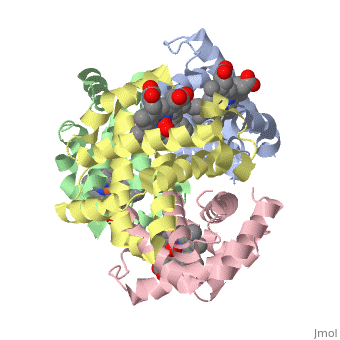Sandbox Reserved 1395
From Proteopedia
(Difference between revisions)
| Line 1: | Line 1: | ||
<scene name='77/777715/1bna/1'>Text To Be Displayed</scene>{{Sandbox_Reserved_HLSC322}}<!-- PLEASE ADD YOUR CONTENT BELOW HERE --> | <scene name='77/777715/1bna/1'>Text To Be Displayed</scene>{{Sandbox_Reserved_HLSC322}}<!-- PLEASE ADD YOUR CONTENT BELOW HERE --> | ||
| - | == | + | ==Hemoglobin== |
| - | <StructureSection load=' | + | <StructureSection load='1gzx' size='340' side='right' caption='This is hemoglobin. The chains and heme groups can be seen.' scene=''> |
This is a default text for your page ''''''. Click above on '''edit this page''' to modify. Be careful with the < and > signs. | This is a default text for your page ''''''. Click above on '''edit this page''' to modify. Be careful with the < and > signs. | ||
You may include any references to papers as in: the use of JSmol in Proteopedia <ref>DOI 10.1002/ijch.201300024</ref> or to the article describing Jmol <ref>PMID:21638687</ref> to the rescue. | You may include any references to papers as in: the use of JSmol in Proteopedia <ref>DOI 10.1002/ijch.201300024</ref> or to the article describing Jmol <ref>PMID:21638687</ref> to the rescue. | ||
| Line 8: | Line 8: | ||
== Disease == | == Disease == | ||
| + | '''Sickle Cell Anemia''' | ||
| + | For the most part, amino acid sequences can be slightly different, but sometimes a change in the sequence can have a large impact. For example, in sickle cell anemia, glutamate 6 in the beta chain is mutated to valine, resulting in a structural change that allows hemoglobin to stick to each other and create stiff fibers, which creates the sickle shape in blood cells. | ||
== Relevance == | == Relevance == | ||
== Structural highlights == | == Structural highlights == | ||
| + | Hemoglobin is made of four protein chains. Each chain looks like myoglobin, which is used to store oxygen in muscles. Each individual chain has a heme group that has an iron atom that allows oxygen to bind. Of the chains, two are beta chains and two are alpha chains. | ||
| + | |||
| + | |||
| + | In the chain, the heme group has iron that allows the oxygen to bind. | ||
This is a sample scene created with SAT to <scene name="/12/3456/Sample/1">color</scene> by Group, and another to make <scene name="/12/3456/Sample/2">a transparent representation</scene> of the protein. You can make your own scenes on SAT starting from scratch or loading and editing one of these sample scenes. | This is a sample scene created with SAT to <scene name="/12/3456/Sample/1">color</scene> by Group, and another to make <scene name="/12/3456/Sample/2">a transparent representation</scene> of the protein. You can make your own scenes on SAT starting from scratch or loading and editing one of these sample scenes. | ||
Revision as of 21:36, 22 February 2018
| This Sandbox is Reserved from January through July 31, 2018 for use in the course HLSC322: Principles of Genetics and Genomics taught by Genevieve Houston-Ludlam at the University of Maryland, College Park, USA. This reservation includes Sandbox Reserved 1311 through Sandbox Reserved 1430. |
To get started:
More help: Help:Editing |
Hemoglobin
| |||||||||||
References
- ↑ Hanson, R. M., Prilusky, J., Renjian, Z., Nakane, T. and Sussman, J. L. (2013), JSmol and the Next-Generation Web-Based Representation of 3D Molecular Structure as Applied to Proteopedia. Isr. J. Chem., 53:207-216. doi:http://dx.doi.org/10.1002/ijch.201300024
- ↑ Herraez A. Biomolecules in the computer: Jmol to the rescue. Biochem Mol Biol Educ. 2006 Jul;34(4):255-61. doi: 10.1002/bmb.2006.494034042644. PMID:21638687 doi:10.1002/bmb.2006.494034042644

